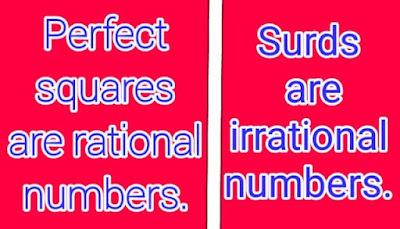In Mathematics, we have to come across lots of numbers. In these numbers, there come perfect squares, surds, terminating decimals, non-terminating decimals, repeating decimals, and non-repeating decimals etc. We usually divide these numbers into two categories. The first category is known as rational numbers and the second category is known as irrational numbers. No doubt, understanding the difference between rational and irrational numbers is a difficult task for the students. Here, we will try to explain the difference between rational and irrational numbers with the help of examples.

Difference Between the Definitions of Rational and Irrational Numbers
Definition of Rational numbers
In Mathematics, rational numbers are those numbers that are written in the form of p/q such that q≠0. The condition for the rational numbers is that both p and q should belong to Z and Z is a set of integers. The simplest examples of the rational numbers are given below;
· 1/9
· 10 or 10/1
Definition of Irrational Numbers
The irrational numbers are those numbers that are not written in the form of p/q. The simplest examples of irrational numbers are given below;
· √3
· 3/0
Difference Between Rational and Irrational Numbers
Most of the students can’t understand the difference between rational and irrational numbers just with the help of their definitions. They require more detail to understand the difference between rational and irrational numbers. The key difference between them is given below;
1. Perfect Squares are Rational Numbers and Surds are Irrational Numbers

All the perfect squares are rational numbers. The perfect squares are those numbers that are the squares of an integer. In other words, if we multiply an integer with the same integer, we get a perfect square. The examples of the perfect squares are √ 4, √ 49, √ 324, √ 1089, and √ 1369. After taking the square roots of these perfect squares, we get 2, 7, 18, 33, and 37 respectively. 2, 7, 18, 33, and 37 are all integers.
On the other hand, all the surds are the irrational numbers. Surds are those numbers that are not the squares of an integer. In other words, these are not the multiples of an integer with itself. Here, the examples of the surds are √2, √3, and √7. After taking the square roots of these surds, we get 1.41, 1.73, and 2.64 respectively. 1.41, 1.73, and 2.64 are not integers.
2. Terminating Decimals are Rational Numbers
All the terminating decimals are rational numbers. Terminating decimals are those decimals that have a finite number of digits after the decimal point. For example, 1.25, 2.34, and 6.94 are all rational numbers. On the other hand, non-terminating decimals are those numbers that have an infinite number of digits after the decimal point. For example, 1.235434…, 3.4444… and 6.909090… are all non-terminating decimals. Non-terminating decimals can be rational or irrational. These are explained in the next point.
3. Repeating Decimals are Rational Numbers and Non-Repeating Decimals are Irrational Numbers

All the repeating decimals are rational numbers and the repeating decimals are those decimals whose digits repeat over and over again. The examples of the repeating decimals are .33333333, .222222, and .555555. On the other hand, all the non-repeating decimals are irrational numbers and the non-repeating decimals are those digits which don’t repeat over and over again. Therefore, the examples of non-repeating decimals are .0435623, .3426452, and .908612. Math lovers will also like to read about types of triangles and types of angles with pictures.
Key Point
The numbers which are written without denominators are rational numbers. Examples of these kinds of numbers are 8 and 9. These numbers are written in the form of p/q as 8/1 and 9/1. The numbers whose denominators are 0 are called irrational numbers like 8/0 and 9/0.
Is ½ or 0.5 a Rational or Irrational Number?
0.5 is called the rational number because it can be written in the form of p/q like 5/10. Moreover, it is also a terminating decimal.
Is Pi (π) a Rational or Irrational Number?
Pi (π) is an irrational number. Its reason is that it gives us non-repeating decimal 3.14159……
Is ‘0’ or ‘Zero’ Rational or Irrational?
‘0’ or ‘Zero’ is a rational number. Its reason is that ‘0’ or ‘Zero’ belongs to the set of integers and we have discussed that all the integers are rational numbers.
Is it possible for us to Find Irrational Numbers Between Two Rational Numbers?
It is easy for us to find irrational numbers between two rational numbers. We try to learn this concept with the help of an example. Find irrational numbers between 3 and 4. We can find the irrational numbers between these two rational numbers by following these steps;
i. First of all, we should find squares of the given numbers. In this case, the squares of 3 and 4 are 9 and 16 respectively.
ii. Secondly, you should find the prime numbers between their squares. The prime numbers between 9 and 16 are 11 and 13.
iii. Lastly, by taking the square root of these prime numbers, we get the required irrational numbers. The square roots of 11 and 13 are 3.316624… and 3.6055512… respectively. As 3.316624… and 3.6055512… are non-repeating decimals. That’s why these are irrational numbers.
The difference in Tabular Form
Key Point
You can easily express the rational numbers in the fraction form. On the other hand, you can’t express the irrational numbers in the fraction form. This is the basic difference between rational and irrational numbers.
Practical Examples
After understanding the difference between rational and irrational numbers, we try to separate the rational and irrational numbers from given numbers. Separate the rational and irrational numbers from the following numbers;
√5, √25, 5/4, 6/5, √36, √8, 16/3, 6/7
√5 is an irrational number because it is a surd and it is not the square of an integer with itself. √25 is a rational number because it is a square of an integer 5 with itself. 5/4 (1.25) is also a rational number. It is a terminating decimal because it has a finite number of digits after the decimal point. 6/5 (1.2) is also a rational decimal because it has also a finite number of digits after the decimal point.
√36 is also a rational number because it is a perfect square. √8 is an irrational number because it is a surd. The answer to the fraction 16/3 is 5.33333… It means that it is a repeating decimal. As we know that repeating decimals is also a rational number. The answer to the fraction 6/7 is 0.85714… It means that it is a non-repeating decimal and we have learned that all the non-repeating decimals are irrational numbers.
Conclusion
In the end, we can clearly understand the difference between rational and irrational numbers with the help of these essential points:
♦ Firstly: Rational numbers = Perfect squares + Terminating decimals + Repeating decimals
♦ Secondly: Irrational numbers = Surds + Non-repeating decimals
You just need to take an overview of a number. In fact, if it is a perfect square, terminating decimal, or repeating decimal, it means that it is a rational number. On the other hand, if it is a surd or non-repeating decimal, it means that it is an irrational number.






This is an awful page. Full of mathematical misinformation.
This informɑtion is invaluabⅼe. When can I find
out more?